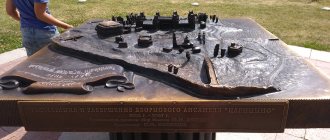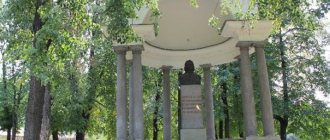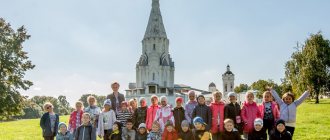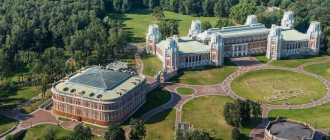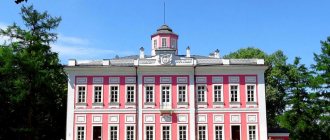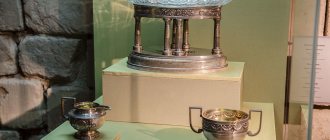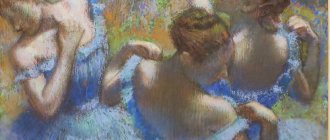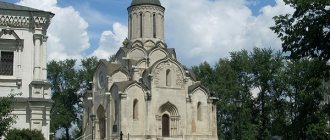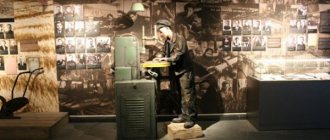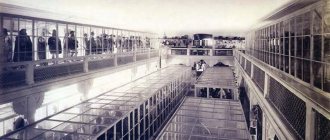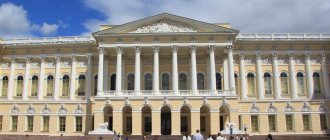Tsaritsyno is one of the most unusual and beautiful estates in Moscow. The history of Tsaritsino is bizarre and full of unexpected events, ups and downs. The mystery of Tsaritsyno has never been solved; it is connected with the name of the Russian Empress Catherine II.
It was by Catherine’s decree that a landscape park and an architectural complex called Tsaritsyno were created for her. Nowadays there is a modern and popular Tsaritsyno park, which has preserved traces of its former charm.
History of Tsaritsyno
Website: tsaritsyno-museum.ru
The history of Tsaritsyno began in 1755, when Catherine II arrived in Moscow. Driving to Kolomenskoye, she admired the beauty of the Black Dirt estate, owned by Prince Sergei Dmitrievich Kantemir. The Empress bought the estate and renamed it “Tsaritsyno”.
Visiting rules
You cannot take bags or backpacks with you into palaces and exhibitions. They must be left in lockers. You can take pictures, but do not use flash or tripods.
To find budget accommodation (hotels, apartments, houses) in Moscow, we recommend using the Hotellook service, where you can find a huge number of accommodation options at different prices and with high ratings.
Vasily Bazhenov
To build a new residence, Catherine hires the court architect Vasily Bazhenov. She entrusts him with the creation of a landscape park and palace buildings in the Moorish style.
Bazhenov has been passionately building the royal estate for 10 years. According to his plan, the architectural buildings should look like a scattering of buildings that naturally fit into the landscape of the ancient park. The building materials used are red brick and white stone.
Nearby imperial palaces were built: for the empress and her son-heir Paul, and somewhat later a smaller palace for her grandchildren. They were the main palace building.
In addition to them, the Middle and Small Palace for Catherine, the Great Cavalry Building - the main building in the ensemble, for the Empress's courtiers, the Kitchen Building (Bread House), three cavalry buildings, the Chamber-Jungfer building, as well as pavilions and bridges, a landscape park is planned.
Big bridge over the ravine
The Big Bridge across the ravine is a ceremonial bridge with arched spans 80 meters long, an outstanding creation of Vasily Bazhenov that has come down to us.
In conditions of scarce funding, the architect has to take out loans on himself in order to continue construction. He has to constantly write letters to officials about the allocation of additional funds.
The entire project is agreed upon in writing with Catherine II, by 1785 it is almost ready, the only thing missing is the finishing of the buildings, since the customer cannot answer what to choose for this. Also, the Clock Tower and the Stable Building were not built, since consent was not given for this.
On June 5, 1985, Ekaterina arrives in Moscow and sees Bazhenov’s creation in reality for the first time. After spending a little time in the estate and seeing some of the premises, the empress leaves Tsaritsino. Her verdict was harsh: radical reconstruction of the main palaces is needed, since the ceilings are too low, the rooms are cramped, the staircases are narrow, and the halls are dark. Instead of triumph, an outstanding architect receives disgrace.
Catherine II's decision to rebuild completely finished buildings, previously approved by her, was unprecedented. The reason for this decision is still not clear and remains the main secret of the Tsaritsyn estate. Vasily Bazhenov was removed from further construction, the project was transferred to his student and assistant Matvey Kazakov. For Bazhenov, this, of course, became a personal drama. He was removed from the post of court architect.
Tsaritsynsky forest
The territory of the estate is quite impressive. In addition to palaces, there are also forests and ponds. The scale of the park allows crowds of visitors, including foreign tourists, to freely explore the property or relax on a bench in the shade of trees without disturbing each other.
Observation deck on an abandoned grotto
Well-groomed alleys of Tsaritsyn Park
Endless paths and a sea of greenery
The mystery of Tsaritsyno
Historians name several possible reasons why Catherine II rejected Bazhenov’s buildings; which of them is correct is not known for certain.
First reason
The connection between the architect Vasily Bazhenov and the Masonic lodge and its leader, journalist and public figure Nikolai Novikov. Catherine brutally dealt with Novikov, sending him to the Shlisselburg fortress for 15 years without trial, without finding a single crime behind him. By the way, this is another mystery of Catherine the Great, why the talented enlightener angered her so much. Novikov will be released from prison by Emperor Pavel after the death of his mother. As for Bazhenov, after searches, as a result of which no prohibited literature was found, he avoided arrest and continued his work as an architect.
The second reason
The Empress simply did not like the palaces. During the 10 years of construction, Catherine’s taste changed and Bazhenov’s “gentle gothic” was rejected by the empress, who gravitated towards classicism.
Third reason
Catherine lost interest in Tsaritsyno because she was carried away by the new construction project - the Pella palace and park complex, being built on the banks of the Neva (territory of the city of Otradnoye, Leningrad region). In 1784, she acquired the Ivanovskaya manor, where construction of a new favorite began with great enthusiasm. Pella suffered an even more tragic fate than Tsaritsyno - after the death of Catherine, by decree of Emperor Paul, all buildings were dismantled. Pella was Catherine's favorite vacation spot, for which she paid the price at the hands of her vengeful son.
Fourth reason
Catherine did not want to live in Moscow; she preferred the suburbs of St. Petersburg. That is why construction with a new architect lasts another 10 years, and is also financed from time to time. Interest in Tsaritsyno has been completely lost; construction cannot be completed.
Tsaritsyn Ponds
What’s good is that the park has been completely restored. Even on the other side of the ponds there are alleys with benches. The ponds themselves were also improved, the banks were strengthened, they were cleaned, bridges were built, and ducks and swans were brought in. The boat station has been reopened.
Tsaritsyn Ponds
Island in a big pond
Nature of Tsaritsyn Park
Another small island in the lake
Matvey Kazakov
Grand Palace, modern version
Six months later, Kazakov presented a new design for the palace, which was approved. The Bazhenov palaces for the empress, the heir and his children were completely dismantled, as well as the chamber-Jungfer building. Matvey Kazakov is building a luxurious palace in the classicist style with Gothic elements: arched windows, pointed towers.
Grand Palace
The new palace is being built slowly due to insufficient funding. In 1793, the Empress ordered the third floor and the throne room to be removed in order to save money. The Great Cavalry Corps was dismantled for building materials.
Services and special products
Tsaritsyno offers its visitors various services such as restaurants, children's playgrounds, a sports ground, boating, bicycle and scooter rentals, and small electric cars. You have up to six shops or places to buy souvenirs. The main store is located in the underground space of the Grand Palace.
As for specialties, the Third Cavalry Corps offers a variety of jams prepared according to 19th-century recipes and three types of very original herbal teas, as well as unique games for children related to the location.
But the most typical thing for visitors to Tsaritsyn is to rent ancient costumes from the 18th century and take pictures in them with family or friends in the Tauride Hall of the Grand Palace (from 300 to 400 rubles per person).
After Catherine's death
In 1796, Catherine dies. By this time, the Grand Palace is not completely ready, the roof is covered with a temporary black roof, the premises are still unfinished. The new Emperor Pavel arrived in Tsaritsino in 1797, he did not like the estate, which was predictable, everything that related to his mother was hateful to him, and a decree was issued not to carry out any construction. All subsequent emperors showed no desire to complete the construction of the Great Palace and use it for its intended purpose.
At the beginning of the 19th century, Tsaritsino became a popular place for public walks. Some royal buildings are being converted into taverns and hotels. Romantic pavilions, gazebos, grottoes, and a ruin tower are being built according to the designs of Vasily Bazhenov’s student, architect Ivan Egotov. Tables and chairs are installed in the pavilions for the public to relax.
Gazebo "Temple of Ceres"
At the end of the 19th century, the buildings turned into dachas and lost their historical appearance: terraces and sheds were added to them. The holiday village of New Tsaritsyno appears, where many celebrities live.
After the revolution of 1917, the village of Lenino was created on the territory of Tsaritsyno. Some palace buildings house communal apartments, a club, a cultural center, and a museum. In 1960, Lenino became part of Moscow.
Large-scale restoration of buildings, except for the Grand Palace, began in the mid-1980s. In 2004, Tsaritsyno Park was transferred to the balance of the city of Moscow. In 2005, at the instigation of Mayor Yuri Luzhkov, a large-scale and rapid restoration of the Grand Palace and park area began, despite protests from restorers, art critics and architects. On September 2, 2007, on Moscow City Day, the grand opening of the renovated palace complex took place, which was attended by Putin.
The Tsaritsyno estate arose at the whim of Catherine II, but despite 20 years of construction and changes in projects, the empress did not want to live here. None of the imperial family ever disturbed the peace of the disgraced estate. Throughout its long history, Tsaritsino did not become a Moscow imperial residence, although it deserved it no less than Peterhof, Gatchina, Tsarskoe Selo, Pavlovsk or Oranienbaum.
Great Palace, ruins
For many years, Tsaritsino was shrouded in a romantic and mysterious aura due to its picturesque ruins and ancient neglected park. The huge ruin of the Grand Palace gradually disappeared into the landscape. After Luzhkov decided to restore order in Tsaritsino, regardless of the historical heritage, as he did more than once, the park became crowded and noisy. Now it is an ordinary modern amusement park, loved by the public. Exhibitions, concerts, light and music performances are held here, the magic of Tsaritsyn is lost forever.
Mysterious houses “for gentlemen”
Photo: histrf.ru
— The Tsaritsyno ensemble, in addition to the main palace, includes many other, smaller buildings. For whom and what were they intended?
— Bazhenov built five palaces, of the five, two have survived - Small and Middle. These are palaces for Catherine. The middle palace is sometimes called the Opera House because in the 19th century they wanted to give concerts there. By that time, Tsaritsyno had already come under the control of the district department, and it was necessary for the estate to generate income for the treasury. Buildings began to be rented out, and a holiday village arose. All the other small buildings you are talking about are now called Cavalry Corps.
—What were these buildings intended for?
— This name was given to them already in the 20th century, during certification. After the Great Patriotic War, Tsaritsino was included in the list of cultural monuments - first of local, and then of all-Union significance. And in the process of certification a difficulty arose. Firstly, by that time not all archival documents had been brought up. In addition, even Bazhenov himself does not write in his letters for whom these houses are intended - for him the external image of the estate was more important. Therefore, it is impossible to say for sure why these buildings were built, there are only different assumptions. For example, in one of his letters to Ekaterina, Bazhenov wrote that he had built a house for waiters, but what kind was unknown. Perhaps this is the smallest house on the territory, hence it is the most extreme. This building differs from the others in its more modest decoration. But this is again just an assumption. So, returning to the Cavalry Corps. In Bazhenov’s version there was a Great Cavalry Corps, which was subsequently demolished by the Cossacks. Now the old foundation remains on this site. Bazhenov himself gave this name, and, apparently, it remained in memory many years later. Therefore, in the 20th century, three buildings were called Cavalry Corps - First, Second and Third.
— The name reminds of cavalry - as if it were something military...
Photo: histrf.ru
- No, not cavalry, but cavaliers - that is, courtiers. Although almost all of our visitors who pass by these buildings read “kavalersky” instead of “kavalersky”. And there is another building, from which the foundation and name have also been preserved: “Kamer-Jungfarsky building”. "Jungfrau" are the girls who serve Catherine. Thus, with the arrival of Kazakov, the central part of the ensemble and the entire composition as a whole changed, since Bazhenov did not have a dominant palace; Kazakov singled it out. On the one hand, he needed to please the Empress, and on the other, to fit the Grand Palace into Bazhenov’s ensemble. We can see how he dealt with this today.
— The building where we are now also seems very interesting. And the name is unusual - “Bread House”.
— With the name, everything is very simple: when this building was built, Bazhenov was going to set up a kitchen here. But there is something really interesting: on the facades of the building you can see two mysterious emblems resembling a loaf of bread and a salt shaker. There are suspicions that they are connected with the Masonic order. The rector of the Institute of Architecture, Dmitry Shvidkovsky, in one of his articles mentions Masonic symbols on the local buildings.
Garrison of Paul I
Paul I, who replaced Catherine II on the throne, did not like his mother’s palace. He trimmed the trees in the Golovinsky Garden in the shape of roosters and peacocks, and built a parade ground in front of the royal residence. The Moscow garrison regiment of Nikolai Arkharov was housed in luxurious chambers. The Arkharovites, recruited into the regiment from the bottom, brutally suppressed riots in the capital, and at the same time were the most effective police officers - they solved the most complicated thefts and other criminal offenses within a day. Since then, the service wings of the Catherine Palace began to be called the Red Barracks. They belong to the military to this day: now the Combined Arms Academy of the Armed Forces of the Russian Federation is located in the building of the Catherine Palace.
Participants in the Lefortovo Maneuvers festival of historical reconstruction. Photo: Pavel L Photo and Video / Shutterstock.com
Concert activities
Concert programs are held in the museum buildings and in open areas. In the atrium of the Bread House there is a small organ from GlÖtter Gets weighing 2.5 tons with three manuals. Tsaritsyno also houses Steinway & Sons pianos, harpsichords, harps, double basses, timpani and other musical instruments [ source not specified 78 days
].
The museum regularly hosts music festivals:
- “Classics and Jazz”, dedicated to Russia Day[25]
- “Circle of Light” (since 2013)[26]
- “Romance of Summer” (since 2014)[27]
- Musical October[28]
Notes
- Egorychev, 2007, p. 38.
- Egorychev, 2007, p. 28.
- Egorychev, 2007, p. 29-31.
- Samutina, 2014, p. 27.
- Egorychev, 2007, p. 29-31.
- Egorychev, 2007, p. 34.
- Samutina, 2014, p. 28.
- Egorychev, 2007, p. 36.
- Dokuchaev, 2005, p. 68.
- Samutina, 2014, p. thirty.
- Egorychev, 2007, p. 38.
- Samutina, 2014, p. 31-32.
- Egorychev, 2007, p. 42.
- Samutina, 2014, p. 95.
- Egorychev, 2007, p. 44.
- Samutina, 2014, p. 46.
- Samutina, 2014, p. 106.
- Dokuchaev, 2005, p. 150, 209, 224.
- Dokuchaev, 2005, p. 150, 182, 200.
- Dokuchaev, 2005, p. 150-154, 176.
- Dokuchaev, 2005, p. 227.
- In “Tsaritsyno” the secrets of the history of the museum-reserve will be revealed. RIA Novosti (May 7, 2017). Retrieved August 7, 2021.
- Samutina, 2014, p. 109-111.
- The new exhibition introduces Dachny Tsaritsyno and its inhabitants. Russia - Culture (May 23, 2017). Retrieved August 7, 2018.
- The international festival “Classics and Jazz” took place at the Tsaritsyno Museum-Reserve. Russia - Culture (June 13, 2013). Retrieved August 7, 2021.
- The light show is ahead. Russian newspaper (September 23, 2017). Retrieved August 7, 2021.
- Music festival “Romance of Summer” in Tsaritsyno. KudaGo (July 4, 2014). Retrieved August 7, 2021.
- The Tsaritsyno Museum-Reserve became the site of the Musical October festival. Southern Horizons (July 17, 2018). Retrieved August 7, 2021.
Singing fountain
There is a unique structure on the territory of the reserve that invariably attracts the attention of guests of the complex. We are talking about the “Singing Fountain”. Its diameter is 55 meters. The fountain consists of 807 jets, which synchronously rise to a height of 15 meters to the sound of a melody. The lighting consists of 3312 lamps. The fountain is only open in spring and summer.
Sloboda Leforta
In 1702, the German Settlement consisted of about 340 households of foreigners who came to Russia to work. These were artisans, merchants, wine merchants, but for the most part ─ mercenaries who served in the Russian army. Among them was the Dutch military man of Geneva origin, Franz Lefort, who went to “try his luck” in distant Muscovy.
Monument to Peter I and Franz Lefort on Krasnokazarmennaya Street.
By chance, the Russified Lefort ─ he managed to get married and rise to the rank of colonel ─ became close to Peter I, becoming his closest friend and adviser. In gratitude for his services to the Russian state, Lefort was given a palace by decree of the emperor: it was built on the right bank of the Yauza in 1696-99. Peter's associate did not have time to enjoy the thoughtfulness of the construction and the rich decoration of the premises: three weeks after the completion of the work, Franz Lefort fell ill with a fever and died. From then on the German settlement began to be called Lefortovo. In 1999, in honor of the celebration of the 300th anniversary of the Lefortovo district, an 8-meter monument to the great reformer Peter I and the outstanding military leader Franz Lefort was erected at the main entrance to Lefortovo Park. Both figures are the same height ─ according to the authors of the monument, this symbolizes that great friends always communicated “as equals.”
Entertainment in the park
- Boat and catamaran rides. Prices - 300 rubles for 30 minutes. Boat rental is open every day except Monday until 8 pm.
Cost of renting boats and pedalos
- Feeding ducks and swans. Don't forget to bring bread with you. Birds are practically not afraid of people; you can get very close to them. Your child will be satisfied.
- Order a personal excursion with a transfer vaguely similar to a tuk-tuk.
Manor greenhouses
Flower farming appeared here in the 18th century, when Cantemir owned the surrounding lands. In the 2000s, the ancient buildings were restored. In the First Greenhouse Building, unusual plants of the tropics and subtropics are grown - various types of palm trees, beautifully blooming Chinese hibiscus, hybrid fuchsia and giant passionflower.
In the Grape Greenhouse, all conditions have been created for fruit-bearing plants - grapes and citrus fruits, which were once supplied to the royal table. The second building collected spicy and essential oil crops. The fragrant “bouquet” of this case is complemented by pineapples and ficus, oregano and rue.
Third Cavalry Corps
